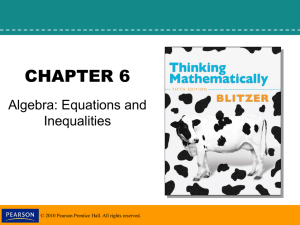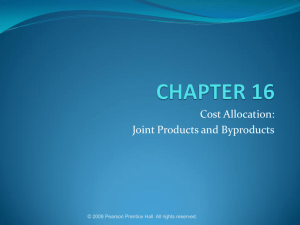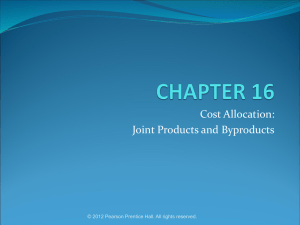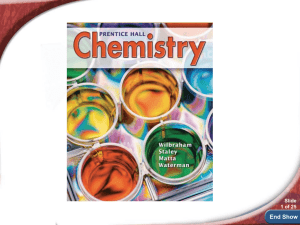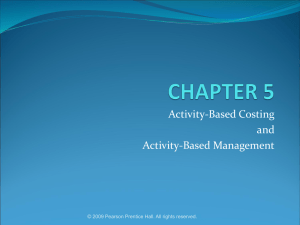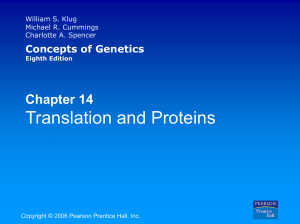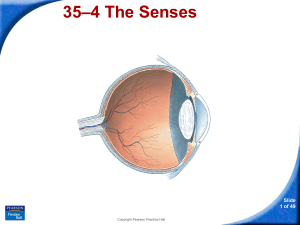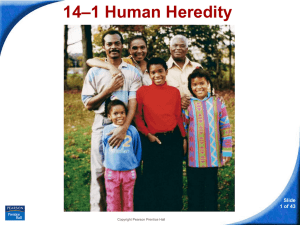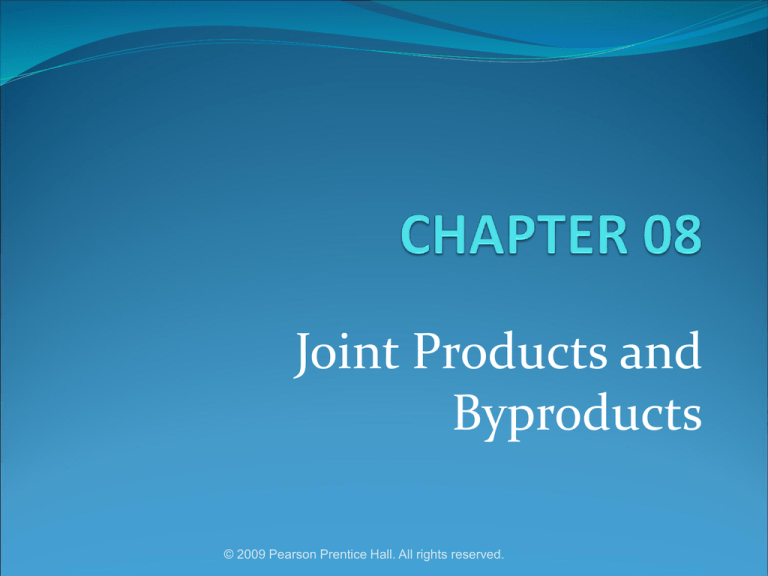
Joint Products and
Byproducts
© 2009 Pearson Prentice Hall. All rights reserved.
Joint Products
Joint products are two or more products separated
in the course of processing, each having
sufficiently high saleable value. For example:
Products from oil refining process petrol and deisel.
There will be joint cost for producing these
products and these costs will be distributed over
products using different methods.
© 2009 Pearson Prentice Hall. All rights reserved.
Methods of distribution of Joint Costs
Physical unit Method
Sales Value of production at split off point
Net Realisable Value ( Expected final sales price –
further expenses to process)
© 2009 Pearson Prentice Hall. All rights reserved.
Physical-Measure Method
Allocates joint costs to joint products on the basis of
the relative weight, volume, or other physical measure
at the splitoff point of total production of the products
© 2009 Pearson Prentice Hall. All rights reserved.
Sales Value at Splitoff Method
Uses the sales value of the entire production of the
accounting period to calculate allocation percentage
Ignores inventories
© 2009 Pearson Prentice Hall. All rights reserved.
Net Realizable Value Method
Allocates joint costs to joint products on the basis of
relative NRV of total production of the joint products
NRV = Final Sales Value – Separable Costs
© 2009 Pearson Prentice Hall. All rights reserved.
Sell-or-Process Further Decisions
In Sell-or-Process Further decisions, joint costs are
irrelevant. Joint products have been produced, and a
prospective decision must be made: to sell
immediately or process further and sell later.
Joint Costs are sunk
Separable Costs need to be evaluated for relevance
individually
© 2009 Pearson Prentice Hall. All rights reserved.
Sell-or-Process Further Example
Final Sales Value= units x sales price per unit
after processing
= 200,000
Sales value at Split off = units x sales price per
unit at split off =(150,000)
Incremental Revenues
= 50,000
Further processing costs
= (40,000)
Profit or (Loss) due to further process
= 10,000
© 2009 Pearson Prentice Hall. All rights reserved.
By Products
By products are outputs of some value produced
incidentally in manufacturing something. For
example:
Sawdust and bark are secondary products from timber
industry.
© 2009 Pearson Prentice Hall. All rights reserved.
Byproducts
Two methods for accounting for byproducts
Production Method – recognizes byproduct inventory
as it is created, and sales and costs at the time of sale
Sales Method – recognizes no byproduct inventory,
and recognizes only sales at the time of sales:
byproduct costs are not tracked separately
© 2009 Pearson Prentice Hall. All rights reserved.
Comparative Income Statements for
Accounting for Byproducts
© 2009 Pearson Prentice Hall. All rights reserved.
Questions
© 2009 Pearson Prentice Hall. All rights reserved.
Exercise No.01
The Builden Company produces three joint
products Builden, buildeze and Buildrite.
Total joint production cost for the November
was $21,600
Additional Data:
Builden Buildeze Buildrite
Units produced
6000
8000
10,000
Sales price per unit $2.2
$1.25
$1.28
Required: Allocation of cost among
products using:
1. The Sales Value Method
2. The Physical Unit Method
© 2009 Pearson Prentice Hall. All rights reserved.
Exercise No.02
The Tracy company manufactures joint products X and Y as
well as Byproduct Z. Cumulative cost data for the period show
$204,000, representing 20000 completed units processed in
Refining Department at an average cost of 10.20. Costs are
assigned to X and Y by Net Realizable value method which
considers further processing costs in subsequent operations.
To determine the cost allocation to Z, the production method
is used. Additional Data:
Z
X
Y
Quantity processed
2000
8000
10,000
Sales price per unit
$5
$20
$25
Further processing
cost per unit
$1
$5
$7
Marketing and admin exp $1
Required: Cumulative cost allocated to Z,X and Y.
© 2009 Pearson Prentice Hall. All rights reserved.
Exercise No.03
The Domecq Company produces three products using
A, B and C as a result of initial joint processing plus
separable further processing. Records show the
following :
A
B
C
Units produced
6000
12000
6250
Units sold
4000
9000
4250
Further processing costs $50,000
$80,000
$70,000
Sales price per unit
$50
$37.50
$40.00
Total Joint Costs: $320,000
Required: calculate the following using NRV
method:
1.
Total production cost of each product.
2.
Total profit of each product.
© 2009 Pearson Prentice Hall. All rights reserved.
Exercise No.04
CBA Company produces three products using C, B and
A . During February the following information was
recorded:
C
B
A
Units produced
2000
5000
3000
Units sold
1500
4200
2400
Further processing costs $8,000
$5,000
$2,000
Sales price per unit
$10
$6
$7
Total Joint Costs: $28,000
Required: calculate the:
1.
Total production cost of each product using
NRV value method.
2.
Total profit of each product.
© 2009 Pearson Prentice Hall. All rights reserved.
Exercise No.05
Vreeland Company produces three products X, Y and Z
. The joint cost totals $60,000. Additional information
was recorded:
X
Y
Z
Units produced
2000
4000
2000
Further processing costs $9,000
$7,000
$5,000
Market value at split off $40,000
$35,000
$25,000
Final market value
$55,000
$45,000
$30,000
Required: calculate from the above figures:
1.
Total production cost of each product using
Net Realizable Value method.
2.
Total production cost for each product using
the average unit method.
© 2009 Pearson Prentice Hall. All rights reserved.
Exercise No.06
Newport Company produces three products R, S and T
. The joint cost totals $350,000. Additional information
was recorded:
R
S
T
Units produced
20,000
50,000
30,000
Further processing costs$40,000
$60,000
$30,000
Unit sales price
$7
$5
$8
Required: calculate from the above figures:
1.
Gross Profit of each product assuming that
all units produced were sold using Net
Realisable value method.
2.
A decision as to whether Product R should
be sold at the split off point for $4.5 per unit
or processed further and sold for $7 per unit.
© 2009 Pearson Prentice Hall. All rights reserved.
Exercise No.07
The Laerock Company ‘s joint cost of producing
1000 units of product A, 500 units of product B
and 500 units of product C is $100,000. The unit
sales values of three products at split off point are
A-$20; B-$200; C-$160. Ending inventories include
100 units of A, 300 units of B and 200 units of C.
Required:
The amount of joint cost that would be
included in the ending inventory of the
three products using Sales value
method and average unit cost method.
© 2009 Pearson Prentice Hall. All rights reserved.



